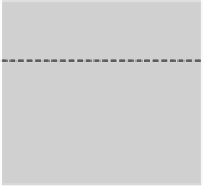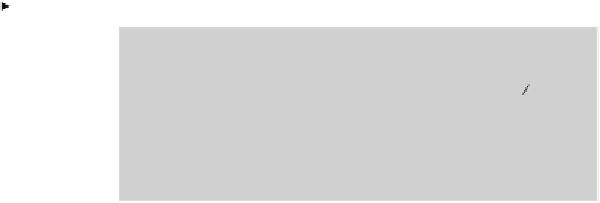Geoscience Reference
In-Depth Information
Next, consider a potential failure mechanism in the form of a circular slip
surface (Fig 12.1b), i.e. a kinematically admissible field. The work performed for a
small rotation
yields for the ultimate state: ½
qB
2
=
2
c
u
R
2
)
. With
B = R
sin
)
/
sin
2
it gives the ultimate load
q =
4
c
u
)
)
, which attains a minimum for
)
=
½ tan
)
=
1.166
radials
=
66.8
o
. The corresponding load is then
q =
5.52
c
u
. This is
an upper limit; the real bearing capacity of the soil is probably lower. Thus, the real
bearing capacity for a strip loading satisfies
giving
)
4
c
u
< q <
5.52
c
u
(12.1)
Prandtl and Reissner suggested a more comprehensive approach where the
plastic area is composed of three zones; zone 1 and 3 according to a Rankine state
(see Fig 7.4) and zone 2 a circular plastic wedge (Fig 12.1c). Kötter's equation for
undrained soil along the
s
-direction (slip line), according to equation (11.5a), yields
1
+
2
c
u
1
=
3
+
2
c
u
3
or
1
=
3
+
2
c
u
(
3
-
1
)
= c
u
+
2
c
u
(
5
/
4
-
3
/
4
) = (1+
)
c
u
(12.2)
i
represents normal stress related to the failure point of the corresponding
Mohr's circle in zone
i
. The ultimate bearing capacity becomes (see Fig 12.1c)
Here,
q =
(1+
)
c
u
+ c
u
=
5.14
c
u
(12.3)
It can be shown that this represents both a lower limit and an upper limit; it is the
real bearing capacity. Unfortunately, the example is one-of-a-kind; other similar
illustrative solutions are scarce.
q
B
q
0
s
3
1
1
3
r
1
2
r
3
r
Figure 12.2a Ultimate bearing capacity for strip loading on drained soil
=
30
o
, c >
0); in
principle, although not indicated, the stresses are effective stresses. Zone 1 is an
active Rankine state with
s-
direction
A similar analysis is elaborated in Fig 12.2a for drained soil (
1
=
(¼
+ ½
) and loaded with
q
, zone 3
a passive Rankine state with
s-
direction
) and loaded with
q
0
(the weight of the soil on top of it), and zone 3 is a plastic wedge, the lower border
of which is a spiral
r/r
1
= e
tan
, and thus:
r
3
/r
1
= e
½ tan
. The spiral is found by
3
=
+ ((¼
½
















































































Search WWH ::

Custom Search